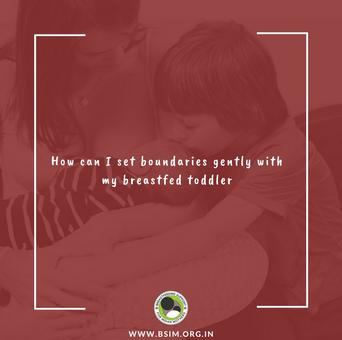How can I set boundaries gently with my breastfed toddler
Breastfeeding is a relationship between the mother and her baby. There are two parties involved and both are important.
WHO recommends that a baby should be breastfed for a minimum of 2 years and beyond. As the baby grows older than that, some mothers may find it difficult to continue to nurse the child due to various reasons listed below and many more.
- Pressure to wean from family and friends
- Fear of embarrassment in public
- Nursing aversions
- Belief that baby is too old to breastfeed
- Need for some space
- exhaustion
It is important to acknowledge the mother’s needs from time to time while not ignoring the child’s needs. In some cases, weaning altogether may be too difficult not just for the child, but even for the mother. That’s when boundary setting can carve a beautiful way out to continue nursing while taking the needs of both mother and baby into account.
Boundary Setting Techniques:
It is important to understand that this is different from gentle mother-led weaning as here, the focus is not on cutting down the nursing sessions. The focus is on increasing and enhancing the mother’s comfort level. Also, these boundaries are set very gradually over time and with children above the age of 2 years. They can be talked and reasoned about with the child. Some commonly used boundaries are as follows..
- No more nursing outdoors. This includes parks, cafes, malls etc.
- No more nursing just because of boredom. It can also help the child identify her moods and encourage her to find ways to keep herself engaged in activities.
- No more nursing at meal times.
- No more nursing while traveling (in the car, aircrafts etc).
- Not nursing when the mother is busy with her work.
- Nursing only at home.
- Nursing only when the child is sleepy.
These are just examples. Boundaries can be introduced to address the individual circumstances and situational demands faced by the mother-child dyad. Thus, a mother can design and set her own boundaries depending on her own needs. More boundaries can be introduced with time.

Wish to speak with a member of our team who is a certified lactation professional and also an experienced breastfeeding mother, click on this link.
Medical Advice Disclaimer
THIS WEBSITE DOES NOT PROVIDE MEDICAL ADVICE.
The information, including but not limited to, text, graphics, images and other material contained on this website are for informational purposes only. No material on this site is intended to be a substitute for professional medical advice, diagnosis or treatment. Always seek the advice of your physician or other qualified health care provider with any questions you may have regarding a medical condition or treatment before undertaking a new health care regimen, and never disregard professional medical advice or delay in seeking it because of something you have read on this website.
Disclaimer
We understand and acknowledge that parents and babies can be of various genders on a spectrum of LGBTQI+. Families come in diverse flavours. However, in our articles, for the sake of simplicity and convenience, we will be referring to the breastfeeding parent as the mother and using the female pronouns- ‘she’ and ‘her’ for babies. Babies can be nourished and nurtured in different ways and while we have used the terms breastfeeding and nursing, we recognize that parents can opt to chest feed or finger feed.
We don’t have conflicts of interest and declare, and we are compliant with the WHO code of marketing of breastmilk substitutes and the IMS act.
In case you find any information on this website that needs to be updated, please write to us at info@bsim.org.in






